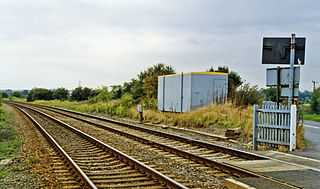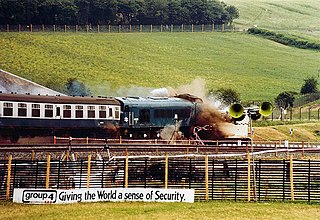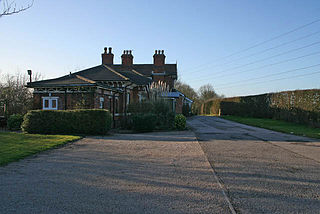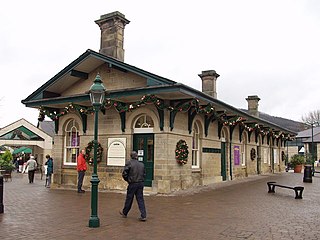
Ashchurch for Tewkesbury is a railway station on the main Bristol–Birmingham main line, serving the market town of Tewkesbury and the village of Ashchurch in Gloucestershire, England. It is located less than 1⁄4 mile (400 m) from junction 9 of the M5 motorway. Originally opened in 1840 but closed in 1971. The station was reopened on 1 June 1997 by Railtrack. There are regular bus connections from the station to Tewkesbury town centre, Gloucester and Cheltenham.

Oakham railway station serves the county town of Oakham in Rutland, England. The station is situated almost halfway between Leicester – 27 miles (43 km) to the west – and Peterborough – 25 miles (40 km) eastward on the Syston and Peterborough Railway, the line is the Birmingham to Peterborough Line.

Melton Mowbray railway station serves the market town of Melton Mowbray in Leicestershire, England. It is owned by Network Rail and operated by East Midlands Railway, though CrossCountry operates most of the services as part of its Birmingham New Street to Stansted Airport route. The station is on the route of the Syston and Peterborough Railway, which is now part of the Birmingham to Peterborough Line. It has a ticket office, which is staffed part-time, a car park, and help points for times when no staff are present.

Trent railway station was situated near Long Eaton in Derbyshire at the junction of the Midland Railway line from London to Derby and Nottingham. It was unusual in that it did not serve any community, being simply an interchange.

Coalville Town was a railway station at Coalville in Leicestershire on the Leicester to Burton upon Trent Line. Passenger business was carried out at the "Railway Hotel" when the line opened in 1833 until the first Coalville station was opened by the Midland Railway in 1848. The Coalville station was replaced in 1894 and closed in 1964, although the line remains in use for freight.

Asfordby railway station was a station serving the villages of Asfordby and Kirby Bellars in Leicestershire. The station was situated at a level crossing on the road between the two villages. It opened in 1846 and was originally named Kirby, but had been renamed Asfordby by 1863. It closed to passengers in 1951 but remained in use for goods until 1964.

Stamford East railway station was the Stamford and Essendine Railway station in Water Street, Stamford, Lincolnshire. The line was worked by the Great Northern Railway but retained its independence until 1886, when the GNR took the line on perpetual lease.
The Old Dalby Test Track is a railway in the United Kingdom which is used for testing new designs of trains and railway infrastructure. It runs between Melton Mowbray, Leicestershire and Edwalton, on the course of the Midland Railway's route between Kettering and Nottingham which closed to passengers on 1 May 1967, and to goods in 1968. It is 13.5 miles (21.7 km) in length.

Southill was a railway station on the Bedford to Hitchin Line which served the village of Southill in Bedfordshire, England. Opened in 1857, it gave more than a century of service before closing in 1962.
Shefford was a railway station on the Bedford to Hitchin Line which served the town of Shefford in Bedfordshire, England. Opened in 1857, it gave more than a century of service before closing in 1962.

Widmerpool was a railway station serving the village of Widmerpool in Nottinghamshire,England. It was situated on the Nottingham direct line of the Midland Railway between London and Nottingham via Melton Mowbray.

Old Dalby railway station served the village of Old Dalby in Leicestershire, England. It was opened on the Nottingham direct line of the Midland Railway between London and Nottingham, avoiding Leicester. The line still exists today as the Old Dalby Test Track.

Upper Broughton was a railway station serving the village of Upper Broughton in Nottinghamshire, England. It was opened on the Nottingham direct line of the Midland Railway between London and Nottingham, avoiding Leicester. The line still exists today as the Old Dalby Test Track.

Plumtree railway station served the village of Plumtree in Nottinghamshire, England on the Nottingham direct line of the Midland Railway between London and Nottingham, avoiding Leicester. The station is now a pub and grill an the line still is now used as the Old Dalby Test Track. Although is closed towards Nottingham way.

Moira railway station was a railway station at Moira, Leicestershire on the Leicester to Burton upon Trent Line.

Rowsley railway station was opened in 1849 by the Manchester, Buxton, Matlock and Midlands Junction Railway to serve the village of Rowsley in Derbyshire, England. It was resited in 1862.
Edwalton railway station served the village of Edwalton and the nearby town of West Bridgford in Nottinghamshire, England. It was opened on the Midland Railway Melton direct route between London and Nottingham, avoiding Leicester.

Southwell railway station served the town of Southwell in Nottinghamshire, England, from 1847 to 1959. It was a stop on the Rolleston Junction-Mansfield line.

Basford Vernon railway station is a disused railway station that was located on the Robin Hood Line between Nottingham and Mansfield.
The Nottingham direct line of the Midland Railway was a new route created in 1879 to relieve congestion on the established routes of the Midland Railway, in England. It consisted of two connecting lines that, together with part of an existing route, formed a new route from Nottingham to near Kettering. The line was used for Nottingham to London express passenger trains, and for heavy mineral and goods trains heading south. As well as shortening the transit a little, the new line had the effect of relieving congestion on the original main line through Leicester, that had become excessively congested.
















